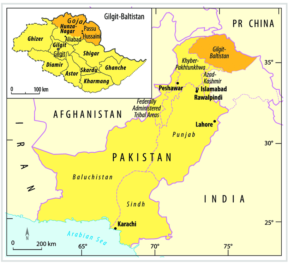In news– Recently, Pakistani authorities have finalised a law to award provisional provincial status to strategically located Gilgit-Baltistan.
Key provisions of the bill-
- The draft of the Bill is titled as ‘26th Constitutional Amendment Bill’
- Under the proposed law by the Ministry of Law and Justice, the Supreme Appellate Court (SAC) of Gilgit-Baltistan may be abolished.
- The region’s election commission is likely to be merged with the Election Commission of Pakistan (ECP).
- Due to sensitivity attached to the region, it could be given provisional provincial status by amending Article 1 of the Constitution.
- It is also proposed that a set of amendments would be introduced to give the region representation in Parliament.
- Once enacted, G-B region would become the 5th province of Pakistan along with its four provinces namely Balochistan, Khyber Pakhtunkhwa, Punjab, and Sindh.
Pakistan wants to give Gilgit-Baltistan a provincial status due to the China-Pakistan Economic Corridor (CPEC) which connects Gwadar Port in Pakistan’s Balochistan with China’s Xinjiang province. However, India has clearly conveyed to Pakistan that the entire Union Territories of Jammu and Kashmir and Ladakh, including the areas of Gilgit and Baltistan, are an integral part of the country by virtue of its fully legal and irrevocable accession.
History of G-B region-
- Gilgit was part of the princely state of Jammu & Kashmir, but was ruled directly by the British, who had taken it on lease from Hari Singh, the Hindu ruler of the Muslim-majority state.
- When Hari Singh acceded to India on October 26, 1947, the Gilgit Scouts rose in rebellion, led by their British commander Major William Alexander Brown.
- The Gilgit Scouts also moved to take over Baltistan, which was then part of Ladakh, and captured Skardu, Kargil and Dras.
- In battles thereafter, Indian forces retook Kargil and Dras in August 1948.
- Before that, on November 1, 1947, a political outfit called the Revolutionary Council of Gilgit-Baltistan had proclaimed the independent state of Gilgit-Baltistan.
- On November 15, it declared it was acceding to Pakistan, which accepted the accession only to the extent of full administrative control.
- Following the India-Pakistan ceasefire of January 1, 1949, Pakistan in April that year entered into an agreement with the “provisional government” of “Azad Jammu & Kashmir” parts that had been occupied by Pakistani troops and irregulars to take over its defence and foreign affairs.
- Under this agreement, the “AJK” government also ceded administration of Gilgit-Baltistan to Pakistan.
Its current status
- While PoK has its own Constitution that sets out its powers and their limits vis-à-vis Pakistan, G-B has been ruled mostly by executive fiat.
- Until 2009, the region was simply called Northern Areas.
- It got its present name only with the Gilgit-Baltistan (Empowerment and Self-Governance) Order, 2009, which replaced the Northern Areas Legislative Council with the Legislative Assembly.
- Currently, it is the northernmost area administered by Pakistan.
- It borders Azad Kashmir to the south, the province of Khyber Pakhtunkhwa to the west, the Wakhan Corridor of Afghanistan to the north, the Xinjiang region of China, to the east and northeast.
- It also borders the Indian-administered union territories Jammu and Kashmir and Ladakh to the southeast.
- Gilgit-Baltistan is six times the size of Azad Kashmir.

















